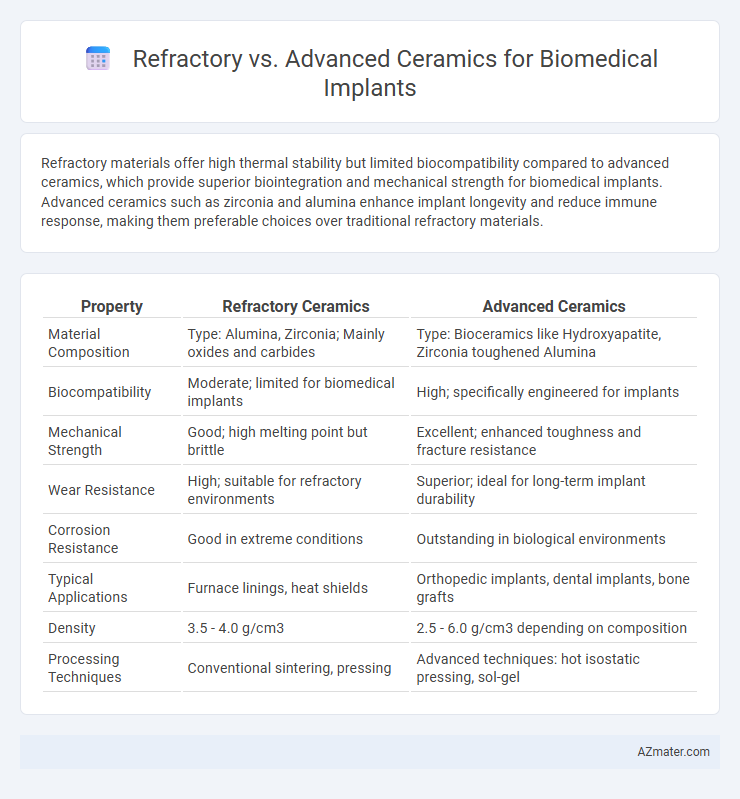Refractory materials offer high thermal stability but limited biocompatibility compared to advanced ceramics, which provide superior biointegration and mechanical strength for biomedical implants. Advanced ceramics such as zirconia and alumina enhance implant longevity and reduce immune response, making them preferable choices over traditional refractory materials.
Table of Comparison
| Property | Refractory Ceramics | Advanced Ceramics |
|---|---|---|
| Material Composition | Type: Alumina, Zirconia; Mainly oxides and carbides | Type: Bioceramics like Hydroxyapatite, Zirconia toughened Alumina |
| Biocompatibility | Moderate; limited for biomedical implants | High; specifically engineered for implants |
| Mechanical Strength | Good; high melting point but brittle | Excellent; enhanced toughness and fracture resistance |
| Wear Resistance | High; suitable for refractory environments | Superior; ideal for long-term implant durability |
| Corrosion Resistance | Good in extreme conditions | Outstanding in biological environments |
| Typical Applications | Furnace linings, heat shields | Orthopedic implants, dental implants, bone grafts |
| Density | 3.5 - 4.0 g/cm3 | 2.5 - 6.0 g/cm3 depending on composition |
| Processing Techniques | Conventional sintering, pressing | Advanced techniques: hot isostatic pressing, sol-gel |
Introduction to Biomedical Implant Materials
Biomedical implant materials must exhibit biocompatibility, mechanical strength, and corrosion resistance to ensure successful integration with human tissue. Refractory ceramics, such as alumina and zirconia, offer high wear resistance and stability at elevated temperatures, making them suitable for load-bearing implants like hip and knee replacements. Advanced ceramics incorporate bioactive properties and enhanced toughness, enabling improved osseointegration and durability in dental implants and bone scaffolds.
Overview of Refractory Ceramics
Refractory ceramics, characterized by their high melting points and exceptional thermal stability, are widely utilized in biomedical implants where resistance to wear, corrosion, and bio-inertness is essential. Common refractory materials like alumina and zirconia exhibit outstanding mechanical strength and biocompatibility, making them suitable for load-bearing applications such as hip and dental implants. Their inherent hardness and chemical resistance contribute to long-term durability, minimizing implant failure and enhancing patient outcomes in orthopedic and dental restorations.
Overview of Advanced Ceramics
Advanced ceramics in biomedical implants exhibit superior biocompatibility, wear resistance, and mechanical strength compared to traditional refractory ceramics. These materials, such as alumina, zirconia, and silicon nitride, offer enhanced corrosion resistance and lower risk of inflammation or rejection. Their tailored microstructures enable improved osseointegration, making them ideal for load-bearing orthopedic and dental implants.
Material Properties Comparison
Refractory ceramics, such as alumina and zirconia, exhibit exceptional hardness, high melting points, and excellent wear resistance, making them suitable for load-bearing biomedical implants. Advanced ceramics like bioactive glass and calcium phosphate offer superior biocompatibility and osteoconductivity, promoting bone integration and tissue regeneration. The choice between refractory and advanced ceramics hinges on balancing mechanical strength with bioactivity to optimize implant performance and longevity.
Biocompatibility: Refractory vs Advanced Ceramics
Refractory ceramics exhibit high chemical inertness and thermal stability but often lack the optimized surface properties required for effective cell integration in biomedical implants. Advanced ceramics such as alumina and zirconia demonstrate superior biocompatibility due to their excellent wear resistance, low toxicity, and ability to promote osteointegration. The enhanced surface characteristics of advanced ceramics significantly reduce inflammatory responses and improve long-term implant success compared to traditional refractory materials.
Mechanical Strength and Durability
Refractory ceramics, such as alumina and zirconia, exhibit high mechanical strength and excellent wear resistance, making them suitable for load-bearing biomedical implants. Advanced ceramics utilized in implants often include bioactive materials like hydroxyapatite, which offer superior biocompatibility but typically have lower mechanical strength compared to refractory ceramics. The durability of refractory ceramics under physiological conditions ensures long-term stability, while advanced ceramics prioritize biological integration with some trade-offs in fracture toughness.
Corrosion and Wear Resistance
Refractory ceramics exhibit excellent corrosion resistance due to their stable oxide layers, making them suitable for biomedical implants exposed to aggressive bodily fluids. Advanced ceramics, such as zirconia and alumina, provide superior wear resistance, crucial for load-bearing implants like joint replacements, reducing debris generation and implant loosening. Both material types ensure long-term implant durability, with advanced ceramics often preferred for their balanced corrosion and wear resistance in dynamic biomedical environments.
Clinical Performance and Applications
Refractory ceramics like alumina and zirconia exhibit exceptional hardness and wear resistance, making them suitable for load-bearing biomedical implants such as hip and knee replacements, with proven long-term clinical performance and biocompatibility. Advanced ceramics, including bioactive glass and hydroxyapatite, enhance osseointegration and promote bone regeneration, supporting applications in dental implants, bone grafts, and coatings for improved implant integration. Clinical outcomes demonstrate that combining refractory ceramics' mechanical strength with advanced ceramics' bioactivity results in optimized implant longevity and patient recovery.
Future Trends in Ceramic Biomedical Implants
Future trends in ceramic biomedical implants emphasize the development of advanced ceramics like zirconia and alumina for enhanced biocompatibility, wear resistance, and mechanical strength compared to traditional refractory ceramics. Innovations in nanostructuring and surface modification are driving improved osseointegration and antibacterial properties, crucial for long-term implant success. Emerging additive manufacturing techniques enable customization and complex geometries, expanding the potential applications of ceramic implants in orthopedics, dental, and cardiovascular fields.
Summary: Choosing the Right Ceramic for Implants
Refractory ceramics offer excellent thermal stability and wear resistance, making them suitable for load-bearing biomedical implants where durability is critical. Advanced ceramics, such as alumina and zirconia, provide superior biocompatibility and mechanical strength, enhancing osseointegration and reducing implant failure rates. Selecting the right ceramic depends on balancing mechanical requirements with biological responses to ensure optimal implant performance and longevity.

Infographic: Refractory vs Advanced ceramic for Biomedical implant
 azmater.com
azmater.com